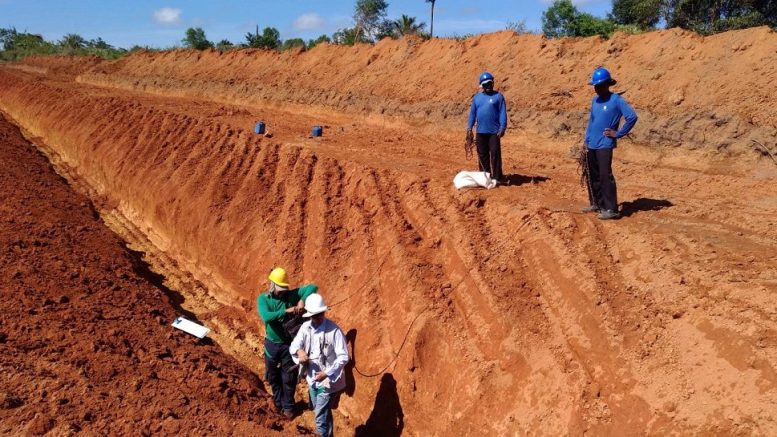Altamira Gold (TSXV: ALTA; US-OTC: EQTRF) wrapped up this year’s trenching program at its Cajueiro gold project in Brazil by finding two gold-bearing structures on the northern end of its Matrincha target, just south of its Baldo target.
Until the start of 2017, Altamira had focused on the project’s Crente zone, which hosts Cajueiro’s entire indicated resource and most of its inferred resource.
In sulphides, the project contains 8.64 million indicated tonnes grading 0.78 gram gold per tonne for 214,000 oz. gold, as well as 9.53 million inferred tonnes at 0.66 gram gold for 204,000 oz. gold. It has another 179,000 inferred oz. gold in oxides.

At Altamira Gold’s Cajueiro gold project in Brazil, from left: contract driller, project geologist Elvis Alves and country manager Sergio Amaro Aquino. Credit: Altamira Gold.
“But now we’ve got our teeth into the Baldo area and Matrincha,” Altamira Gold president and CEO Michael Bennett says in an interview with The Northern Miner. “We’ve discovered these consistent, almost east–west brecciated zones, which are much higher grade. On surface there are grades over 100 grams gold per tonne.”
The company focused its trenching on Matrincha and Baldo because the areas are slightly elevated, compared to other parts of the project. As a result, they feature less soil and saprolitic cover on top of the bedrock, making them easier to trench and sample.
Two trenches from Matrincha, developed 275 metres apart, cut 8.82 grams gold over 1 metre and 5.31 grams gold over 5 metres. The company then cut a parallel zone in both trenches. These returned 18.9 grams gold over 1 metre and 30.19 grams gold over 3.6 metres, including 106.31 grams gold over 1 metre.
The company also completed four trenches at Baldo East and extended the strike length of the Baldo 2 structure to 950 metres. The best trench graded 8.42 grams gold over 4 metres.
“More important than that … you’ve got something happening at depth below our Cajueiro block,” Bennett says. “We need to look at the near-surface resources, but we realize that we are looking at near-surface gold mineralization, which is being fuelled by a deeper intrusive source.”
Bennett says at least five majors, including Anglo American (LON: AAL), Nexa Resources (TSX: NEXA; NYSE: NEXA) and Codelco, are active in the Juruena belt, looking for deeper sources of the gold mineralization. Bennett hopes it’s a porphyry source.
He says Altamira is in contact with several major companies investigating the possibility of working together on deeper exploration within Altamira’s properties.
“It’s something that is not out of our technical hands, but in this market might be out of our financial hands, and where we might need a major to help us,” he says.
With the rainy season beginning, Altamira will put more trenching on hold until early next year. Instead, it will focus on stream sediment and pan concentrate sampling at its newly staked Sao Joaozinho property, south of Cajueiro, as well as its 620 sq. km Santa Helena claim block, in the southern end of the Juruena belt. It will likely do the same on its Cajueiro and Apiacas properties toward year-end.
“During the dry season we could trench,” Bennett says. “We could have taken stream-sediment samples, but it would have been difficult to process them on-site, because there was no water.”
The company will test its stream-sediment samples for base metals, in addition to the gold-focused pan sampling. Altamira just started the sampling program at Santa Helena. It will take the company two months to complete.
“Santa Helena is a very important area,” Bennett says. “We’ve been sampling there recently because the local farmers are digging a few pits in the area, and they’re finding some very high-grade, gold-vein structures.”
 Copper mineralization (green) visible in a sample from Altamira Gold Corp.’s Colíder gold project in the Juruena Mineral Belt of eastern Brazil. Photo Credit: Altamira Gold.
Copper mineralization (green) visible in a sample from Altamira Gold Corp.’s Colíder gold project in the Juruena Mineral Belt of eastern Brazil. Photo Credit: Altamira Gold.
He says that though the veins are only a few metres wide, they are consistent along strike and associated with copper. Santa Helena features hydrothermally altered rocks on surface with either stockwork or parallel quartz veining, and Altamira says the area could overlie a deeper-seated mineralization source. Bennett puts it along with Cajueiro and Apiacas as the company’s three properties that are most prospective for both shallow gold and deeper-seated mineralization.
Meanwhile, Brazil recently wrapped up a presidential election that saw populist pro-business candidate Jair Bolsonaro emerge victorious. It is unclear what impact, if any, this will have on mining regulations in Brazil. Speaking before the election, Bennett said the current system is hampered, not by laws, but by “the agility of the paperwork.”
The Brazilian government has established an agency in the last year to speed up the paperwork related to mineral exploration. Still, staking claims in Brazil can take time.
“Some of the areas we claim go into a bidding process, and that bidding process is very, very slow,” Bennett says. “They’re now thinking of changing that to a much more agile process that can be done online.
“When you’re an exploration company, you need to get the exploration permit and the environmental permit, and spend your money and look for what you’re looking for — not wait and wait and wait for the paperwork to come out. So that’s a really important move in Brazil.”
Shares of Altamira are trading at 9¢ in a 52-week range of 8¢ to 35¢. The company has a $5-million market capitalization.


Be the first to comment on "Altamira cuts high-grade gold in Brazil"